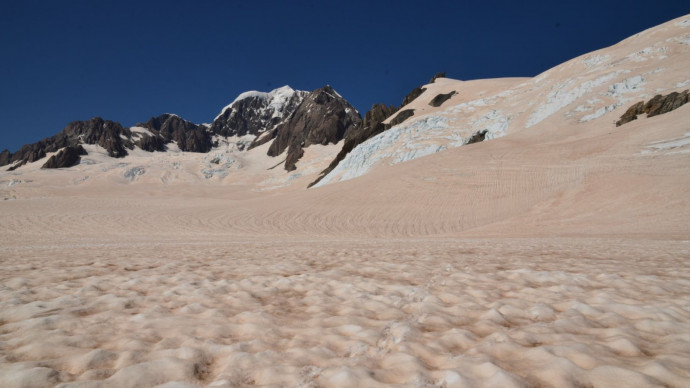Research
Published 20 December 2024The summer the Southern Alps turned red

New research uncovers the real source of the red dust that blanketed the mountains in the summer of 2019/2020 and explains why climate change could see events like this happen more often
When snow on the Southern Alps turned from white to red in the summer of 2019/2020, ash from Australia’s bushfires was blamed. But researchers studying the event now say the real culprit was desert dust storms that sent massive amounts of red dust across the Tasman Sea. These storms are likely to occur more often as the climate warms.
“Media reports in 2020 generally assumed the blanket of red on the mountains was caused by ash swept across the sea from Australia’s devastating New Year bushfires. But the red dust that led to the dramatic colour change actually arrived well before New Year,” said Dr Holly Winton, an environmental scientist at Te Herenga Waka—Victoria University of Wellington and lead author of a new study about the event.
Time-lapse photography of the Southern Alps’ Brewster Glacier, taken by the University’s Associate Professor Brian Anderson, showed the red dust arriving on the mountains in late 2019.
Using geochemical fingerprinting, the researchers analysed samples of the dust from the Fox, Franz Josef, and Tasman glaciers and pinpointed its origin as south-east Australia where it was stirred up by desert dust storms.
Fuelled by high winds that were also driving bushfires, these storms saw an estimated 4,500 tonnes of red mineral dust dumped on top of snow and ice in the Southern Alps. Most of it fell during a two-week period in late November 2019.
“Fresh snowfall quickly buried the dust, but this surface snow melted away in early 2020, coinciding with spectacular skies over New Zealand associated with the Australian bushfires. Not surprisingly, the red mountains and the fires became linked in media reports,” said Dr Winton.
While the dust storm event lasted only a short time, it could have long-term effects.
“The huge amount of dust dumped reduced albedo—that’s the ability of snow to reflect sunlight. The dust particles absorb sunlight. This in turn will raise surface temperatures and increase snow and glacier melt, adding to existing pressures on this environment,” said Dr Winton.
The Southern Alps may well see more of these massive dust dumps in coming years as the climate warms, said project leader Dr Phil Novis, a senior researcher at Manaaki Whenua Landcare Research.
“Climate change is expected to result in increased desertification and dry conditions in many areas so these storms—as well as wildfires that can be driven by similar weather patterns—are likely to occur more often.
“The 2019/2020 event is at least the ninth such event recorded in Aotearoa New Zealand since 1902 and surely one of the most dramatic. We are in the firing line from dust blown across the sea when these events occur in Australia,” said Dr Novis.
Results of the research are published in the journal Geophysical Research Letters. The work, funded by a Marsden Grant from the Royal Society of New Zealand, is part of a wider study looking at the effect of airborne particles on snow and glacier melting.
Additional information: The summer the Southern Alps turned red: VUW press release
Additional information: NZ Southern Alps Blanketed by Red Australian Dust During 2019/2020 Severe Bushfire and Dust Event
RESEARCHER
Holly Winton, Phil Novis, Heather Purdie
ORGANISATION
Victoria University of Wellington, Manaaki Whenua Landcare Research, University of Canterbury
FUNDING SUPPORT
Marsden Fund
CONTRACT OR PROJECT ID
MFP-LCR2003 (Phil Novis) and MFP-UOC1804 (Heather Purdie)
